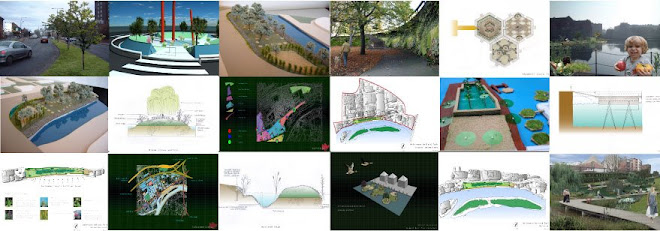Went to Radical Nature at the Barbican on Sunday....I'd been seeing the posters up when I take the tube every now and then and thought it time I go and have a look before it finishes. I have to say it was such a let down, a real shame.

I remembers going to this exhibition space at the Barbican a few years ago to see the Future Cities exhibition and that was unbelievable. Some really exciting projects and models and a sense of real organisation. That was not the case with Radical Nature. First of all taking photographs was not allowed which I thought to be unquestionably stupid, especially considering there was nothing really original or amazing being exhibited.
While to some it may be considered art, and with all due respect to the artist, I thought Henrik Håkansson's Fallen Forest was a waste of space and good plants. They have been on display since June and seemingly struggling to stay alive. I don't think this could be a realistic template for vertical planting, it may make more sense to keep to planting that will gravitationally survive.
The hydroponic system in the centre of the room of Tomas Saraceno, entitled Flying Garden, I found interesting, nonetheless that the plants here too were pretty much on their last legs. It did remind me of a project I posted months back of the Parisian hydroponic Living Green house of R&Sie Architects for the white which (found
here). I understand that this is an exhibition but I think in order to keep it a successful piece, it needs to be properly maintained since it is situated indoors. Just my opinion.
Aside from that, the others were really forgettable, some vegetable patches, a mirrored room for the inhabitat with a tiny garden. Upstairs there were some interesting projects from designers of yesteryear.
I loved the handdrawn images of Newton Fallis' Autopia (1978) and also Wolf Hilbertz's Autopia: Internalised Oceanic (1985). (A beautiful image can be found
here)
Agnes Denes' Wheatfield and Tree Mountain were the most inspirational for me. In 1982, she carried out what has become one of the best-known environmental art projects when she planted a two-acre field of wheat in a vacant lot in downtown Manhattan. Titled, Wheatfield - A Confrontation, the artwork yielded 1,000 lbs. of wheat in the middle of New York City to comment on "human values and misplaced priorities". The harvested grain then traveled to 28 cities worldwide in "The International Art Show for the End of World Hunger" and was symbolically planted around the globe.
As part of Agnes Denes' Wheatfield exhibition, Paris-based experimental architects EXYZT re-created the Wheatfield on a smaller site with a very different backdrop, in part of an abandoned railway line at
The Dalston Junction Eastern Curve. The Dalston Mill was also designed by the Parisian architects, as a temporary structure created in 2008 with Sara Muzio for the Architecture Foundation which was based around the idea of "a community of users actively creating and inhabiting their urban environment [as] key to generating a vibrant city". Both pieces in fact form a temporary functional ensemble and eventually the mill will be processing grains from the field when the wheat is ready to be harvested. More inforamtion about the Dalston Wheatfield and Mill can be found at
http://www.we-make-money-not-art.com/archives/2009/07/the-dalston-mill-wheatfield.php






















